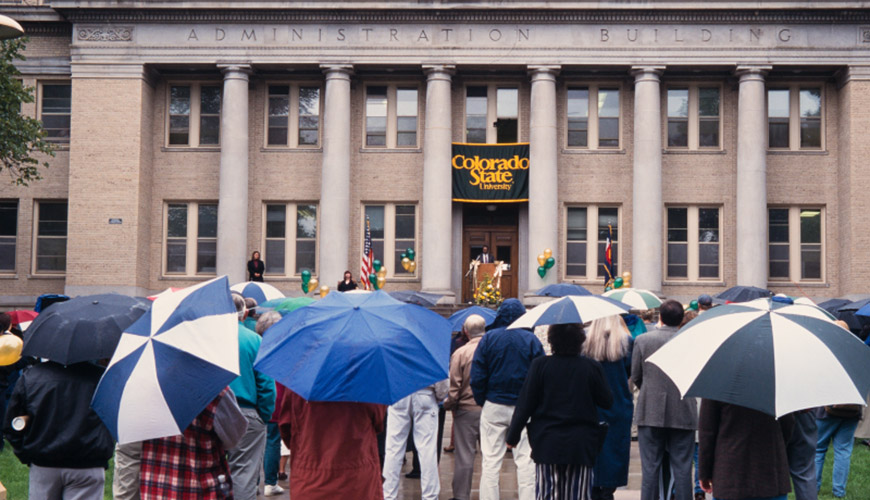
President Al Yates addresses campus during his 1997 Fall Address and acknowledges flood recovery efforts. The annual Fall Address and Picnic tradition, which continues today, began as a celebration of those efforts.
With its power to both give and take away, water is continually transforming the world in one way or another. When feet of water receded after the 1997 Spring Creek Flood inundated Fort Collins, the Colorado State University campus community mourned losses, gathered its spirit, and started to rebuild – with an eye toward preventing such significant damage again. As a result, campus emerged transformed by the power of water.
“Campus is considerably, measurably safer today than it was in 1997 because of efforts the City of Fort Collins and CSU have taken in mitigating effects of future floods,” said Fred Haberecht, assistant director of Facilities Management and campus planner. “The city has mitigated the university’s risk through a $22 million flood mitigation project that nearly cut in half the amount of flood water coming to campus. The university and city have an intergovernmental agreement to mitigate stormwater. The bottom line is that campus is safer because the city has done work, CSU has done work, and we have done work together to mitigate against future flood damage.”
In 1997, the university sustained more than $140 million in damage, with the Morgan Library and Lory Student Center among the hardest hit. Nearly 500,000 books were damaged, and the first floor of Eddy Hall was submerged. Facilities Management pumped 5 million gallons of water out of buildings, leaving behind soggy grounds and 39 water-logged buildings. Thirteen buildings were closed, mostly in the older area of campus, where the Oval resembled a pond:
- College Avenue Gym
- Engineering
- Forestry
- Gibbons
- Johnson Hall
- Lory Student Center
- Morgan Library
- Music (now TILT)
- Eddy
- Education
- Hartshorn (former home of CSU Health Network)
- Occupational Therapy
- Administration Annex (now Centennial Hall).
According to university news releases from the time:
- The high water line in the lower level of the Lory Student Center was just inches below the ceiling, and damage was extensive, at $7.6 million, requiring 107,000 square feet to be renovated. Heralded as a nearly impossible task, by mid-January 1998, just six months after the flood, the university opened a renovated bookstore within the LSC. The store opened with new fixtures that doubled space for textbooks, better ADA accessibility, and a new entrance on the lower level. The changes increased efficiency for students, dramatically reducing their textbook wait time.
- The same week, the Lory Student Center theater opened, rescued from beneath nearly 14 feet of accumulated water. The theater sported a remodeled green room, a completely restored stage, new carpet, a Steinway piano, and reupholstered, repainted and restored cast-iron seats original to the 1962 construction. The 1927 Wurlitzer pipe organ was in the theater at the time, and its thousands of pipes were in the process of being extensively cleaned for reinstallation.
- Just six months after the flood, the Morgan Library received a national honor as the library with the most efficient borrowing system. The library had already processed thousands of book and journal requests by faculty and students, thanks to an electronic service, a process accelerated by the crisis.
Flood mitigation
Within weeks, Facilities Management also began a newly energized flood mitigation plan for campus that focused on building ways to divert and hold floodwaters without impacting buildings or adverse impacts to water flow up or down stream. According to a July 1998 news release, then director of Facilities Management, Ronald Baker, said a cost-effective plan of berms, low walls, reconfigured stairwells, raised vents, waterproofed utility vaults would be put into place to protect buildings at risk of flooding. The plan included 11 floodwalls built around specific buildings, which today blend into the campus’ character and provide places for pedestrians to rest.
Since the flood, the university has invested more than $5 million in flood mitigation measures and drainage improvements. The university and city have worked together to share information and flood protection plans, working together to understand how the actions of one entity could impact the other.
Today, the university continues to consider floods when building new structures. The Lake Street Parking Garage has first floor openings strategically placed to allow floodwater to move through on its way downstream. A big drain is installed by the MAX station to drain the area immediately to the west, and a new detention pond sits near the university’s peaceful lagoon. Added stormwater detention structures now lay buried below the Engineering parking lot and east of the new stadium, while aboveground detention areas exist near Gibbons and Occupational Therapy, the College Avenue Gym, and the new CSU Health and Medical Center.
“During significant storms, Facilities Management workers mobilize to areas of campus known to be prone to flooding,” said Susanne Cordery, university environmental engineer. “Crews work to keep drains clear and floodwater moving away from buildings. The university has really invested in flood mitigation planning and infrastructure which has changed the landscape of campus. It is aimed at helping to prevent a repeat of the level of damage experienced in 1997.”